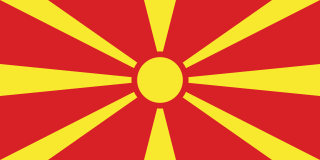
Bitola is a city in the southwestern part of North Macedonia. It is located in the southern part of the Pelagonia valley, surrounded by the Baba, Nidže, and Kajmakčalan mountain ranges, 14 kilometres north of the Medžitlija-Níki border crossing with Greece. The city stands at an important junction connecting the south of the Adriatic Sea region with the Aegean Sea and Central Europe, and it is an administrative, cultural, industrial, commercial, and educational centre. It has been known since the Ottoman period as the "City of Consuls", since many European countries had consulates in Bitola.
Jovica Tasevski-Eternijan is a Macedonian poet, essayist and literary critic.

Goran Stefanovski was a leading Macedonian dramatist, screenwriter, essayist, lecturer and public intellectual. He wrote for the theatre, television and film, as well as pursuing a long academic career in teaching creative writing for the theatre and film.

The groups of people who have settled or controlled the territory of modern-day North Macedonia have influenced the country in many ways, one of the most visible being architecture. These groups of people include the Paionians, Illyrians, Ancient Macedonians, Romans, Byzantines, Bulgarians, Serbs, Ottomans, Yugoslavs, and ethnic Macedonians.

Mijaks are an ethnographic group of Macedonians who live in the Lower Reka region which is also known as Mijačija, along the Radika river, in western North Macedonia, numbering 30,000–60,000 people. The Mijaks practise predominantly animal husbandry, and are known for their ecclesiastical architecture, woodworking, iconography, and other rich traditions, as well as their characteristic Galičnik dialect of Macedonian. The main settlement of the Mijaks is Galičnik.

Goran Trenchovski is a Macedonian-born director, writer, artistic leader, founder, lecturer, humanist. He is the current head of AsterFest, and lives in Great Britain.
Janko Konstantinov is a Macedonian architect and artist.

Vlado Goreski – Rafik is a Macedonian-Slovenian graphic artist and scenographer.

Georgi Konstantinovski was a Macedonian architect, writer and educator. He graduated from the SS Cyril and Methodius University, Faculty of Architecture in Skopje in 1956 and received his Master of Architecture Degree from Yale University, under the mentorship of Paul Rudolph and Serge Chermayeff, in 1965. His early works are stylistically considered Brutalist. In New York City, he worked and collaborated with I. M. Pei, Henry Cobb Jr., and Araldo Cossutta.

The Sanjak of Ohri was one of the sanjaks of the Ottoman Empire established in 1395. Part of it was located on the territory of the Lordship of Prilep, a realm in Macedonia ruled by the Ottoman vassal Prince Marko until his death in the Battle of Rovine.
Mimoza Nestorova-Tomić was a Macedonian architect, planner, and urban designer, who played a significant role in the masterplan and reconstruction of Skopje after the 1963 earthquake. Initially she worked specifically in the team for social planning with Polservice, the Polish consultants, alongside Kenzo Tange, the winner of a United Nations international competition for the reconstruction of Skopje. She got the job as an independent designer and manager of City Office of Urbanism in Skopje in 1965. In the period 1986–1989 Nestorova-Tomić was the director of City Office of Urbanism in Skopje.

Slavko Brezoski was a Macedonian architect, urban planner, painter, writer and educator known for his works in the genre of modern architecture realised during the middle of the 20th century in modern-day North Macedonia, Serbia, Croatia, Brazil and Libya. He was a professor and Dean at the Faculty of Architecture at the Ss. Cyril and Methodius University of Skopje.
Gorno Vranovci is a village in the municipality of Čaška, North Macedonia. The village has an Albanian school and a mosque.

Pagaruša is a village in the municipality of Studeničani, North Macedonia.

Cvetovo is a village in the municipality of Studeničani, North Macedonia.

Dolno Količani is a village in the municipality of Studeničani, North Macedonia.
Držilovo is a village in the municipality of Sopište, North Macedonia.

Jasna Koteska is a Macedonian writer, philosopher and academic.

The House of Dokse Lonovski is a historical house in Galičnik that is listed as cultural heritage of North Macedonia. It is in ownership of one branch of the family of Lonovski.

The House of Slavko Brezovski is a historical house in Galičnik that is listed as Cultural heritage of North Macedonia. It is in ownership of one branch of the family of Brezoski.















